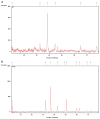A Comparative Evaluation of the Antiproliferative Activity against HepG2 Liver Carcinoma Cells of Plant-Derived Silver Nanoparticles from Basil Extracts with Contrasting Anthocyanin Contents
- PMID: 31366167
- PMCID: PMC6722760
- DOI: 10.3390/biom9080320
A Comparative Evaluation of the Antiproliferative Activity against HepG2 Liver Carcinoma Cells of Plant-Derived Silver Nanoparticles from Basil Extracts with Contrasting Anthocyanin Contents
Abstract
Nanotechnology is a well-established and revolutionized field with diverse therapeutic properties. Several methods have been employed using different reducing agents to synthesize silver nanoparticles (AgNPs). Chemical mediated synthetic methods are toxic and resulted in non-desired effects on biological systems. Herein, we, synthesized silver nanoparticles using callus extract of purple basil (BC-AgNPs) and anthocyanin extract deriving from the same plant (i.e. purple basil) (AE-AgNPs), and systematically investigated their antiproliferative potential against HepG2 Liver Carcinoma Cells. The phyto-fabricated AgNPs were characterized by different techniques like UV-visible spectroscopy (UV-Vis), X-ray diffraction (XRD), Fourier transform infrared spectroscopy (FT-IR), Scanning electron microscopy (SEM) and Energy dispersive X-rays (EDX). Morphologically, both types of NPs were found spherical. The average size of BC-AgNPs and AE-AgNPs as revealed through XRD and SEM analyses were calculated as 50.97 ± 0.10 nm and 42.73 ± 1.24 nm, respectively. FT-IR spectral analysis demonstrates the existence of possible phytochemicals required for the capping and reduction of Ag ions. Herein, following solid phase extraction (SPE) coupled to HPLC analysis, we report for the first-time the anthocyanin mediated synthesis of AgNPs and conforming the successful capping of anthocyanin. Small sized AE-AgNPs showed significant cytotoxic effect against human hepatocellular carcinoma (HepG2) cell line as compared to BC-AgNPs. Therefore, the results revealed that the prevalent group of flavonoids present in purple basil is the anthocyanins and AE-AgNPs could be employed as potential anticancer agents in future treatments strategies.
Keywords: Ocimum basilicum L. var. purpurascens; anthocyanin; characterization; cytotoxicity; silver nanoparticles.
Conflict of interest statement
None
Figures





References
-
- Muhammad W., Khan M.A., Nazir M., Siddiquah A., Mushtaq S., Hashmi S.S., Abbasi B.H. Papaver somniferum L. mediated novel bioinspired lead oxide (PbO) and iron oxide (Fe2O3) nanoparticles: In-vitro biological applications, biocompatibility and their potential towards HepG2 cell line. Mater. Sci. Eng. C. 2019;103:109740. doi: 10.1016/j.msec.2019.109740. - DOI - PubMed
-
- Farias C.B.B., Silva A.F., Rufino R.D., Luna J.M., Souza J.E.G., Sarubbo L.A. Synthesis of silver nanoparticles using a biosurfactant produced in low-cost medium as stabilizing agent. Electron. J. Biotechnol. 2014;17:122–125. doi: 10.1016/j.ejbt.2014.04.003. - DOI
-
- Elgorban A.M., Al-Rahmah A.N., Sayed S.R., Hirad A., Mostafa A.A.-F., Bahkali A.H. Antimicrobial activity and green synthesis of silver nanoparticles using Trichoderma viride. Biotechnol. Biotechnol. Equip. 2016;30:299–304. doi: 10.1080/13102818.2015.1133255. - DOI
Publication types
MeSH terms
Substances
LinkOut - more resources
Full Text Sources

